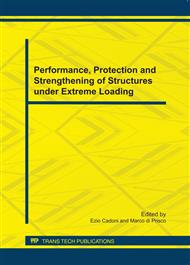p.440
p.446
p.452
p.461
p.467
p.473
p.479
p.485
p.491
Using Perforated Plates as a Blast Wave Shielding Technique for Application to Tunnels
Abstract:
Tunnels are vulnerable to devastating explosions, due to the concentration of explosive energy that would be many times greater than in an unconfined blast. One way to mitigate the damage resulting from an explosion is to disrupt the blast wave as it propagates along a tunnel. This paper presents the results of an investigation into the performance of perforated plates as a blast wave mitigation method in tunnel-like structures. Plastic explosive was detonated at the open end of a small-scale rigid steel tube and the blast wave propagated down the tube towards a thin, steel target plate. Increasing the separation distance between the perforated plate and target plate decreased the target plate deformation and increased the impulse at which tearing initiated. Large plastic displacement of the perforated plates was observed. Ansys Autodyn was used to model the experiments and provide additional insight into the blast wave propagation.
Info:
Periodical:
Pages:
467-472
Citation:
Online since:
July 2011
Authors:
Keywords:
Price:
Сopyright:
© 2011 Trans Tech Publications Ltd. All Rights Reserved
Share:
Citation:


